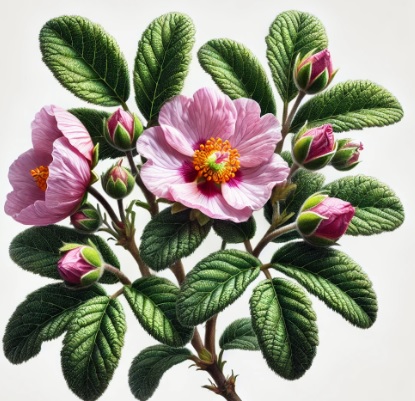Pink rockrose (Cistus incanus) is a species of flowering plant in the Cistaceae family. Native to the Mediterranean region, it is renowned for its attractive pink flowers and aromatic foliage. The plant thrives in rocky, well-drained soils and is often found in scrublands and dry, open areas.
Botanical Classification:
Kingdom: Plantae
Order: Malvales
Family: Cistaceae
Genus: Cistus
Species: Cistus incanus
Plant Characteristics:
Cistus incanus is characterized by:
Size and Shape: A shrub that typically grows between 0.5 to 1.5 meters in height. It has a bushy, spreading form with a somewhat woody base.
Leaves: The leaves are elliptical to ovate, covered with fine, grayish hairs that give them a silvery appearance. They are aromatic and can be slightly sticky to the touch.
Flowers: The flowers are striking, with five petals that are usually pink or pale purple, with darker veins. They are about 4-6 cm in diameter and bloom from late spring to early summer.
Fruit: The fruit is a small, woody capsule that splits open to release seeds. The capsules often persist on the plant after seed dispersal.
Soil and Light: Prefers well-drained soils and full sun. It is well adapted to dry, rocky, and poor soil conditions typical of Mediterranean climates.
Chemical Composition and Structure:
The chemical composition of Cistus incanus includes:
Polyphenols: Contains a variety of polyphenolic compounds, such as flavonoids and tannins, known for their antioxidant properties.
Essential Oils: Includes compounds like cineole, which contributes to its aromatic properties.
Resins: Present in the plant's foliage, contributing to its sticky texture and potential medicinal uses.
Oligomeric Proanthocyanidins (OPCs): These are potent antioxidants found in the plant, which help to neutralize free radicals.
Uses and Benefits:
Medicinal: Cistus incanus has been used traditionally for its anti-inflammatory, antimicrobial, and antioxidant properties. It is often utilized in herbal teas and supplements to support immune health and combat infections.
Cosmetic: Extracts from Cistus incanus are used in skincare products for their antioxidant and anti-aging properties. They help to soothe and protect the skin.
Aesthetic: The plant is valued for its ornamental qualities in garden design. Its striking pink flowers and attractive foliage make it a popular choice for xeriscaping and Mediterranean gardens.
Ecological: Plays a role in soil stabilization and habitat creation in arid and semi-arid regions. It helps to prevent erosion and provides habitat for local wildlife.
Applications:
Medicinal: Used in traditional herbal medicine and modern supplements for its antioxidant, anti-inflammatory, and antimicrobial properties. Commonly found in teas and health products aimed at boosting immune function.
Cosmetics: Incorporated into skincare formulations for its soothing, protective, and anti-aging benefits.
Gardening: Grown as an ornamental plant in gardens, especially in dry and rocky landscapes. Ideal for Mediterranean-style gardens and xeriscaping.
Ecological Restoration: Used in erosion control and habitat restoration projects in arid environments.
Environmental and Safety Considerations:
Environmental Impact: Generally low impact when cultivated responsibly. Beneficial for soil stabilization and ecosystem support in arid regions.
Safety: Generally safe for use. Essential oils and extracts should be used with caution, especially in sensitive individuals, as they may cause skin irritation. Consult with a healthcare provider before using for medicinal purposes, especially if pregnant, breastfeeding, or on medication.
INCI:
Skin conditioning agent. It is the mainstay of topical skin treatment as it has the function of restoring, increasing or improving skin tolerance to external factors, including melanocyte tolerance. The most important function of the conditioning agent is to prevent skin dehydration, but the subject is rather complex and involves emollients and humectants that can be added in the formulation.
Synonyms:
CAS: 93165-04-9 EC number 296-887-9
![]() Pink rockrose
Pink rockrose 
